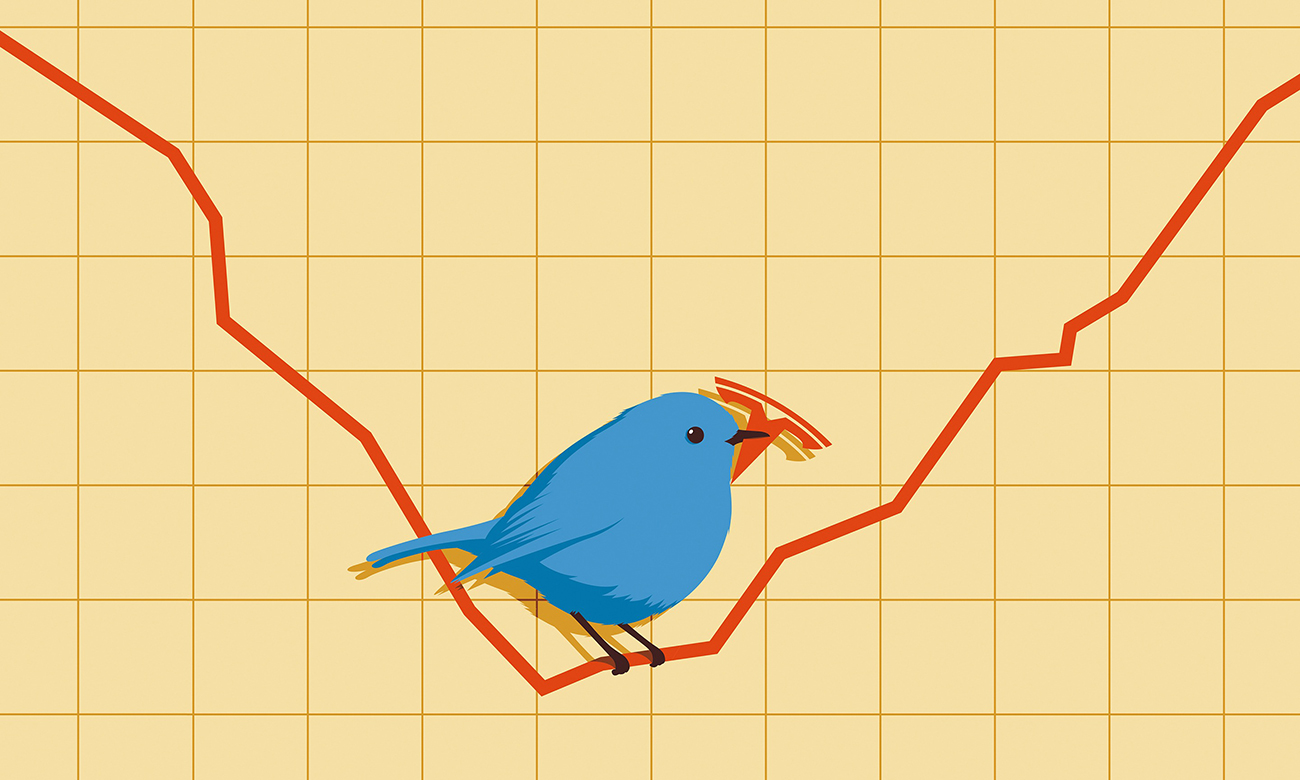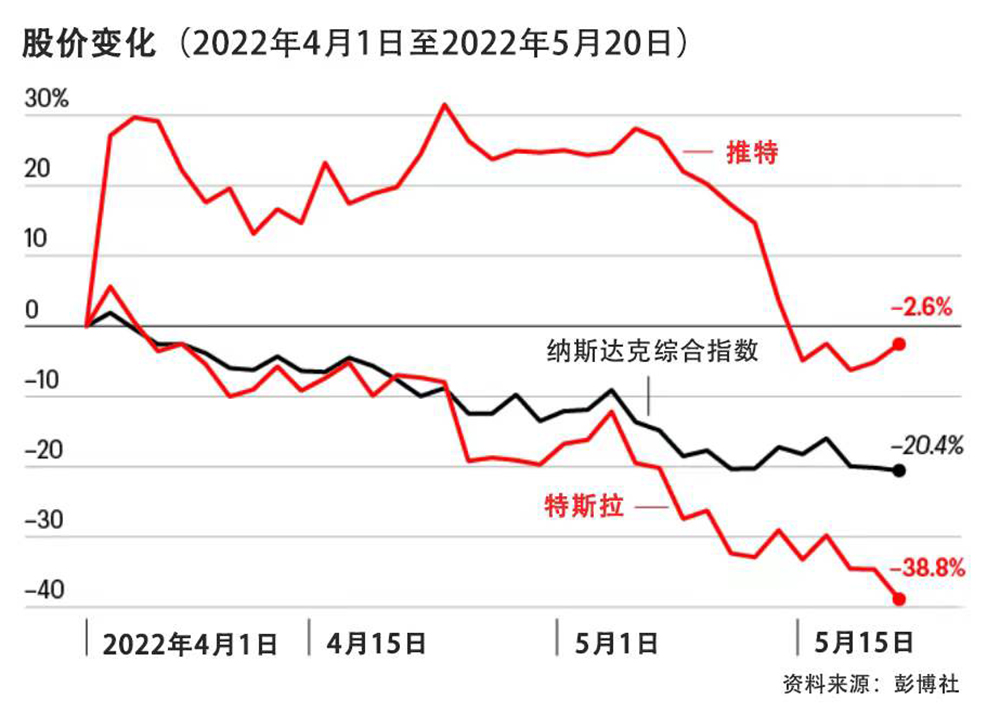
埃隆·马斯克收购推特公司(Twitter)本身便是一个巨大的商业故事,但它隐藏了一个更大的商业故事。
此次竞购让媒体对马斯克收购目标计划议论纷纷。这位大亨希望将这家社交媒体平台转变为一个言论自由的城市广场,这可能意味着恢复美国前总统唐纳德·特朗普的社交媒体账号,让推特成为他的传声筒。专家们想知道,这位特立独行的人是否真的能够像他承诺的那样,可以在五年内将这家深陷困境的公司的收入翻五倍。
到目前为止,马斯克摇摆不定、竞购后宣布暂停,对推特公司的运营和股东来说是一场灾难。在今年4月同意以每股54.20美元的价格将推特公司变成一家私人控股公司后,马斯克在几周后开始拖延时间,声称该平台上“机器人”和虚假账户的数量远远高于推特公司声称的数量。许多人认为马斯克的这一举动是为了以更低的价格达成交易——甚至完全放弃交易。这个问题在本报道发表时仍未解决,但到那时,推特公司的管理层已经陷入混乱,其股价也已经暴跌。

不过,尽管推特公司遭受重创,但迄今为止,这笔交易最大的输家是特斯拉公司(Tesla)的股东,而电动汽车巨头特斯拉公司让马斯克成为偶像。如果马斯克如愿以偿,成为推特公司的主理人和首席执行官,那么这些投资者就将遭受更大的损失。
尽管特斯拉公司最大的长期投资者都没有公开批评马斯克收购推特公司之举,但从其股票的大幅抛售中能够明显看出,许多投资者对该交易嗤之以鼻。从4月1日收盘,即马斯克披露其推特公司初始股份之前,到5月20日,特斯拉的股价下跌了39%。股价下跌抹去了特斯拉公司4330亿美元的市值,这是有史以来在如此短的时间内最大的损失之一。换一种说法:特斯拉公司的市值下跌带来的损失是马斯克收购推特公司提议的440亿美元的近10倍。
收购推特公司的交易并不是特斯拉公司股价下跌的唯一原因(经济衰退带来的威胁必然是另一个原因)。但很容易看出为什么收购推特公司的交易会让股东们心惊肉跳。在特斯拉公司自身面临重大挑战之际,重振推特公司(一家在低利润行业中存在严重现金流问题的公司)所面临的挑战和成本将极大地分散马斯克的注意力。这些挑战,包括其上海超级工厂的关闭、市场份额的下降以及来自全球电动汽车新进入者的激烈竞争,都需要马斯克全力以赴来应对。突然间,被马斯克打动而相信特斯拉的追随者开始质疑他们的英雄怎么可能为另一家公司展开疯狂的改革行动。
特斯拉迷们并不是唯一一群涉及到金钱得失问题的人。作为标准普尔500指数(S&P 500)中市值最大的公司之一,特斯拉公司在5月底的市值为6870亿美元,是大盘股指数基金的主力。这使其成为数千万美国人401(k)s计划(养老基金——译注)和储备金的一部分。例如,截至4月30日,特斯拉在先锋标准普尔500指数ETF基金(Vanguard S&P 500 ETF)中排名第五位,占2.1%,高于伯克希尔-哈撒韦公司(Berkshire Hathaway)、联合健康集团(UnitedHealth Group)和强生公司(Johnson & Johnson)。
当然,即使没有收购推特公司的交易,特斯拉的股价暴跌也可以说是不可避免的。根据特斯拉公司在未来几年内能够实际产生的销售额和利润,其股票被严重高估了。证券研究公司New Constructs的负责人戴维·特雷纳说:“马斯克是个天才,但也是个狡猾的经营者,他通过炒作的方式让特斯拉公司坐上了火箭飞船。”无论结果如何,收购推特公司的这场闹剧都可以证明泡沫破灭。
以下是推特公司收购案对特斯拉公司未来构成的五大威胁——除了高管分心之外。
治理推特公司的费用。在向贷方和投资者的介绍中,马斯克为推特公司设定了几乎不可能实现的目标。最值得注意的是,他的目标是将用户群从2021年的2.17亿增加到2028年的近10亿。投行Jefferies的分析师布伦特·蒂尔指出,他所了解的任何社交媒体平台——包括Facebook——都没有这么快的扩张,而且推特在年轻用户中缺乏人气,无法实现快速增长。
但更大的问题是,用户群增长需要资金,而这一成本可能会以牺牲特斯拉公司的投资者为代价。为了达成这笔交易的融资,马斯克已经出售了他所持有的大约6%的特斯拉股份,价值85亿美元。一位内部人士告诉《财富》杂志,如果交易完成,马斯克可能会持有超过50%的推特公司股份。但这笔交易还要求推特公司承担130亿美元的巨额新债,每年的利息约为6.5亿美元。
长话短说:这些利息可能会耗尽推特公司所有的运营现金,因此,没有任何资本支出能够用于建设技术基础设施以支持更大的用户群。如果推特公司的业绩没有改善,马斯克就将面临压力,需要弥补任何损失,甚至需要提供数十亿美元的新资本。而这反过来又加剧了马斯克需要出售更多特斯拉股票的风险,可能会持续引发股票下跌。
保证金贷款的危险。马斯克的融资蓝图包括质押他自己的312.5亿美元特斯拉股票——按当前价格计算约为4400万股——为收购推特公司获得62.5亿美元的贷款。根据特斯拉公司最近披露的财务信息,马斯克此前已经将8800万股股票质押用于其他借款,但目前尚不清楚他使用了多少信贷。因此,如果他真的动用了这62.5亿美元,他就将总共质押他完全拥有的特斯拉股份的80%左右。
但内部人士的巨额保证金贷款给所有股东带来了巨大的危险。如果特斯拉的股价因为任何原因急剧下跌——比如,因为它失去了市场份额——马斯克的贷方就可以要求他提供更多现金作为抵押。而这反过来又可能迫使他出售更多股票,从而将股票带入死亡陷阱。能够肯定的是,价格急剧下跌才会引发追加保证金。但由于特斯拉的价格相对于它的业绩来说是如此之高——它的市盈率仍然接近90——这种下跌的可能性比一家拥有更大、更安全现金流的老牌公司要大得多。
中国难题。马斯克非常依赖中国的电动汽车销售和生产来推动特斯拉的增长。去年,中国的销售额约占特斯拉总收入的四分之一。尽管短缺问题阻碍了上海工厂的发展,马斯克仍然实现将其产能翻一番,达到每年100万辆的巨大规模。
开放平台的危险。通过收购推特公司,马斯克将进入并驾驭一个高度政治化的领域。他冒着失去特斯拉客户的风险。美国证券交易委员会(Securities and Exchange Commission)的前高级审判律师、律师事务所Moses & Singer的合伙人霍华德·费舍尔说:“他说他会让特朗普回归推特,这个网站可能会成为右翼巨头的游乐场。本来会购买特斯拉汽车的人,会被拒之门外,转而购买雪佛兰(Chevrolet)的Bolt电动汽车或其他车型。将你的品牌与50%的美国人不赞成的观点联系起来可能是一个错误。”
马斯克对美国证券交易委员会。美国证券交易委员会和马斯克不是朋友关系——马斯克收购推特公司可能会让双方的关系变得更糟。监管机构指控马斯克犯有证券欺诈罪,因为他在2018年的推文中声称,他已经获得了将特斯拉私有化的融资。马斯克支付了2000万美元的罚款,并同意在三年内不再担任这家电动汽车制造商的董事长。
现在,马斯克面临来自推特公司股东的诉讼,指控他在规定日期后数周才披露他对该公司的初始投资,违反了证券法规。这个问题可能会引发美国证券交易委员会的另一次调查。马斯克越是激怒美国证券交易委员会,该机构就越有可能仔细审查他关于特斯拉前景的陈述。特斯拉惊人的估值部分取决于对未来多年巨大增长的信心。让美国证券交易委员会不断质疑马斯克在开空头支票可能会打破这种说法。
特斯拉泡沫。当特斯拉公司股价达到1100美元,公司估值达到1万亿美元时,New Constructs的特雷纳整理了一些数据来回答一个亟待解决的问题:特斯拉需要发展到什么程度才可以证明这个价格是合理的?结论:特斯拉公司需要实现极大的发展,比现实中能够实现的发展的规模大的多。根据特雷纳的说法,到2030年,特斯拉每年需要销售1500万辆汽车,高于去年的93.1万辆;根据国际能源署(International Energy Agency)的销售预测,这意味着占据全球电动汽车市场57%的份额。
回到此时此地,越来越多的竞争对手正在电动汽车领域站稳脚跟,而特斯拉公司的主导地位已经在下滑。根据New Constructs和EV-volumes.com的数据,其全球电动汽车市场份额从2019年的16%下滑至去年的14%,2021年其在美国的市场份额为70%,同比下降9个百分点。
特雷纳认为特斯拉公司的合理估值是多少?他最乐观的预测是,特斯拉公司将在2030年售出700万辆汽车,占全球交付量的27%(与今天相比有很大的增长),利润率为9%,这将与丰田汽车(Toyota)近年来公布的行业领先数字持平。在这种情况下,特斯拉股票如今的真实价值是200美元——仅仅是当前价格的四分之一。特雷纳补充说:“如果特斯拉公司未能达到这些预期,那么该公司的估值就将比如今的估值低。”
总之:无论马斯克做什么,特斯拉公司的估值都注定会大幅下跌。他可以保持其作为世界上最有价值——甚至是最重要的——汽车制造商的地位,但前提是他必须聚焦汽车领域,放弃执掌推特公司。特斯拉股价进一步下跌带来的震惊,可能说服马斯克结束他的推特公司收购案。在经历了资本主义史上最快的超级明星崛起之后,他大概不希望出现同样戏剧性的下跌。(财富中文网)
本文另一版本登载于《财富》杂志2022年6/7月刊,标题为《马斯克收购推特中最大的输家:特斯拉的投资者》(The big losers in Musk’s Twitter bid: Tesla investors)。
译者:中慧言-王芳
埃隆·马斯克收购推特公司(Twitter)本身便是一个巨大的商业故事,但它隐藏了一个更大的商业故事。
此次竞购让媒体对马斯克收购目标计划议论纷纷。这位大亨希望将这家社交媒体平台转变为一个言论自由的城市广场,这可能意味着恢复美国前总统唐纳德·特朗普的社交媒体账号,让推特成为他的传声筒。专家们想知道,这位特立独行的人是否真的能够像他承诺的那样,可以在五年内将这家深陷困境的公司的收入翻五倍。
到目前为止,马斯克摇摆不定、竞购后宣布暂停,对推特公司的运营和股东来说是一场灾难。在今年4月同意以每股54.20美元的价格将推特公司变成一家私人控股公司后,马斯克在几周后开始拖延时间,声称该平台上“机器人”和虚假账户的数量远远高于推特公司声称的数量。许多人认为马斯克的这一举动是为了以更低的价格达成交易——甚至完全放弃交易。这个问题在本报道发表时仍未解决,但到那时,推特公司的管理层已经陷入混乱,其股价也已经暴跌。
不过,尽管推特公司遭受重创,但迄今为止,这笔交易最大的输家是特斯拉公司(Tesla)的股东,而电动汽车巨头特斯拉公司让马斯克成为偶像。如果马斯克如愿以偿,成为推特公司的主理人和首席执行官,那么这些投资者就将遭受更大的损失。
尽管特斯拉公司最大的长期投资者都没有公开批评马斯克收购推特公司之举,但从其股票的大幅抛售中能够明显看出,许多投资者对该交易嗤之以鼻。从4月1日收盘,即马斯克披露其推特公司初始股份之前,到5月20日,特斯拉的股价下跌了39%。股价下跌抹去了特斯拉公司4330亿美元的市值,这是有史以来在如此短的时间内最大的损失之一。换一种说法:特斯拉公司的市值下跌带来的损失是马斯克收购推特公司提议的440亿美元的近10倍。
收购推特公司的交易并不是特斯拉公司股价下跌的唯一原因(经济衰退带来的威胁必然是另一个原因)。但很容易看出为什么收购推特公司的交易会让股东们心惊肉跳。在特斯拉公司自身面临重大挑战之际,重振推特公司(一家在低利润行业中存在严重现金流问题的公司)所面临的挑战和成本将极大地分散马斯克的注意力。这些挑战,包括其上海超级工厂的关闭、市场份额的下降以及来自全球电动汽车新进入者的激烈竞争,都需要马斯克全力以赴来应对。突然间,被马斯克打动而相信特斯拉的追随者开始质疑他们的英雄怎么可能为另一家公司展开疯狂的改革行动。
特斯拉迷们并不是唯一一群涉及到金钱得失问题的人。作为标准普尔500指数(S&P 500)中市值最大的公司之一,特斯拉公司在5月底的市值为6870亿美元,是大盘股指数基金的主力。这使其成为数千万美国人401(k)s计划(养老基金——译注)和储备金的一部分。例如,截至4月30日,特斯拉在先锋标准普尔500指数ETF基金(Vanguard S&P 500 ETF)中排名第五位,占2.1%,高于伯克希尔-哈撒韦公司(Berkshire Hathaway)、联合健康集团(UnitedHealth Group)和强生公司(Johnson & Johnson)。
当然,即使没有收购推特公司的交易,特斯拉的股价暴跌也可以说是不可避免的。根据特斯拉公司在未来几年内能够实际产生的销售额和利润,其股票被严重高估了。证券研究公司New Constructs的负责人戴维·特雷纳说:“马斯克是个天才,但也是个狡猾的经营者,他通过炒作的方式让特斯拉公司坐上了火箭飞船。”无论结果如何,收购推特公司的这场闹剧都可以证明泡沫破灭。
以下是推特公司收购案对特斯拉公司未来构成的五大威胁——除了高管分心之外。
治理推特公司的费用。在向贷方和投资者的介绍中,马斯克为推特公司设定了几乎不可能实现的目标。最值得注意的是,他的目标是将用户群从2021年的2.17亿增加到2028年的近10亿。投行Jefferies的分析师布伦特·蒂尔指出,他所了解的任何社交媒体平台——包括Facebook——都没有这么快的扩张,而且推特在年轻用户中缺乏人气,无法实现快速增长。
但更大的问题是,用户群增长需要资金,而这一成本可能会以牺牲特斯拉公司的投资者为代价。为了达成这笔交易的融资,马斯克已经出售了他所持有的大约6%的特斯拉股份,价值85亿美元。一位内部人士告诉《财富》杂志,如果交易完成,马斯克可能会持有超过50%的推特公司股份。但这笔交易还要求推特公司承担130亿美元的巨额新债,每年的利息约为6.5亿美元。
长话短说:这些利息可能会耗尽推特公司所有的运营现金,因此,没有任何资本支出能够用于建设技术基础设施以支持更大的用户群。如果推特公司的业绩没有改善,马斯克就将面临压力,需要弥补任何损失,甚至需要提供数十亿美元的新资本。而这反过来又加剧了马斯克需要出售更多特斯拉股票的风险,可能会持续引发股票下跌。
保证金贷款的危险。马斯克的融资蓝图包括质押他自己的312.5亿美元特斯拉股票——按当前价格计算约为4400万股——为收购推特公司获得62.5亿美元的贷款。根据特斯拉公司最近披露的财务信息,马斯克此前已经将8800万股股票质押用于其他借款,但目前尚不清楚他使用了多少信贷。因此,如果他真的动用了这62.5亿美元,他就将总共质押他完全拥有的特斯拉股份的80%左右。
但内部人士的巨额保证金贷款给所有股东带来了巨大的危险。如果特斯拉的股价因为任何原因急剧下跌——比如,因为它失去了市场份额——马斯克的贷方就可以要求他提供更多现金作为抵押。而这反过来又可能迫使他出售更多股票,从而将股票带入死亡陷阱。能够肯定的是,价格急剧下跌才会引发追加保证金。但由于特斯拉的价格相对于它的业绩来说是如此之高——它的市盈率仍然接近90——这种下跌的可能性比一家拥有更大、更安全现金流的老牌公司要大得多。
中国难题。马斯克非常依赖中国的电动汽车销售和生产来推动特斯拉的增长。去年,中国的销售额约占特斯拉总收入的四分之一。尽管短缺问题阻碍了上海工厂的发展,马斯克仍然实现将其产能翻一番,达到每年100万辆的巨大规模。
开放平台的危险。通过收购推特公司,马斯克将进入并驾驭一个高度政治化的领域。他冒着失去特斯拉客户的风险。美国证券交易委员会(Securities and Exchange Commission)的前高级审判律师、律师事务所Moses & Singer的合伙人霍华德·费舍尔说:“他说他会让特朗普回归推特,这个网站可能会成为右翼巨头的游乐场。本来会购买特斯拉汽车的人,会被拒之门外,转而购买雪佛兰(Chevrolet)的Bolt电动汽车或其他车型。将你的品牌与50%的美国人不赞成的观点联系起来可能是一个错误。”
马斯克对美国证券交易委员会。美国证券交易委员会和马斯克不是朋友关系——马斯克收购推特公司可能会让双方的关系变得更糟。监管机构指控马斯克犯有证券欺诈罪,因为他在2018年的推文中声称,他已经获得了将特斯拉私有化的融资。马斯克支付了2000万美元的罚款,并同意在三年内不再担任这家电动汽车制造商的董事长。
现在,马斯克面临来自推特公司股东的诉讼,指控他在规定日期后数周才披露他对该公司的初始投资,违反了证券法规。这个问题可能会引发美国证券交易委员会的另一次调查。马斯克越是激怒美国证券交易委员会,该机构就越有可能仔细审查他关于特斯拉前景的陈述。特斯拉惊人的估值部分取决于对未来多年巨大增长的信心。让美国证券交易委员会不断质疑马斯克在开空头支票可能会打破这种说法。
特斯拉泡沫。当特斯拉公司股价达到1100美元,公司估值达到1万亿美元时,New Constructs的特雷纳整理了一些数据来回答一个亟待解决的问题:特斯拉需要发展到什么程度才可以证明这个价格是合理的?结论:特斯拉公司需要实现极大的发展,比现实中能够实现的发展的规模大的多。根据特雷纳的说法,到2030年,特斯拉每年需要销售1500万辆汽车,高于去年的93.1万辆;根据国际能源署(International Energy Agency)的销售预测,这意味着占据全球电动汽车市场57%的份额。
回到此时此地,越来越多的竞争对手正在电动汽车领域站稳脚跟,而特斯拉公司的主导地位已经在下滑。根据New Constructs和EV-volumes.com的数据,其全球电动汽车市场份额从2019年的16%下滑至去年的14%,2021年其在美国的市场份额为70%,同比下降9个百分点。
特雷纳认为特斯拉公司的合理估值是多少?他最乐观的预测是,特斯拉公司将在2030年售出700万辆汽车,占全球交付量的27%(与今天相比有很大的增长),利润率为9%,这将与丰田汽车(Toyota)近年来公布的行业领先数字持平。在这种情况下,特斯拉股票如今的真实价值是200美元——仅仅是当前价格的四分之一。特雷纳补充说:“如果特斯拉公司未能达到这些预期,那么该公司的估值就将比如今的估值低。”
总之:无论马斯克做什么,特斯拉公司的估值都注定会大幅下跌。他可以保持其作为世界上最有价值——甚至是最重要的——汽车制造商的地位,但前提是他必须聚焦汽车领域,放弃执掌推特公司。特斯拉股价进一步下跌带来的震惊,可能说服马斯克结束他的推特公司收购案。在经历了资本主义史上最快的超级明星崛起之后,他大概不希望出现同样戏剧性的下跌。(财富中文网)
本文另一版本登载于《财富》杂志2022年6/7月刊,标题为《马斯克收购推特中最大的输家:特斯拉的投资者》(The big losers in Musk’s Twitter bid: Tesla investors)。
译者:中慧言-王芳
Elon Musk’s campaign to buy Twitter is a big business story that’s masking an even bigger one.
The bid has had the media buzzing about Musk’s plans for his takeover target. The mogul wants to transform the social media platform into an anything-goes town square, which might mean restoring Donald Trump’s megaphone. And pundits wonder whether the maverick can really quintuple the ailing company’s revenues in five years, as he’s been promising.
So far, Musk’s vacillating, race-then-retreat pursuit has been a disaster for Twitter’s operations and stockholders. After agreeing in April to take Twitter private at $54.20 a share, Musk began stalling a few weeks later, alleging that the number of “bots” and fake accounts on the platform was far higher than Twitter claimed. Many have seen that gambit as an effort by Musk to recast the deal at a far lower price—or even walk away entirely. That issue was unresolved as this story went to press, but by then Twitter’s management ranks were in turmoil, and its shares had cratered.
Still, despite the pummeling that Twitter has taken, the deal’s biggest losers thus far are shareholders at the company that made Musk an icon: Tesla, the electric-car juggernaut. And those investors stand to lose far more if Musk gets his wish and becomes Twitter’s principal owner and CEO.
Though none of the biggest, long-standing Tesla investors have publicly criticized Musk’s Twitter play, it’s obvious from the sharp selloff in its shares that many investors despise the deal. Between the market closes on April 1, just before Musk disclosed his initial Twitter stake, and May 20, Tesla’s stock crumbled 39%. The nosedive erased $433 billion in value, one of the largest wipeouts ever over such a short span. To frame it differently: Tesla’s market cap fell by almost 10 times the $44 billion Musk offered for Twitter.
The Twitter deal isn’t the only reason Tesla is down (the threat of recession is certainly another). But it’s easy to see why it makes shareholders squeamish. The challenge and the cost of fixing Twitter—a company with big cash-flow problems in a low-margin industry—would create a huge distraction for Musk at a time when Tesla faces major challenges of its own. Those challenges, including shutdowns at its gigafactory in Shanghai, falling market share, and burgeoning competition from new EV entrants worldwide, demand Musk’s full commitment. Suddenly, the followers whom Musk has moved to believe in Tesla are questioning how their hero could embark on a crazy crusade for another company.
Fanboys and girls aren’t the only ones with money at stake. As one of the biggest companies in the S&P 500 by market cap, at $687 billion in late May, Tesla is a staple in large-cap index funds. That makes it part of the 401(k)s and nest eggs of tens of millions of Americans. For example, as of April 30, Tesla ranked as the fifth-largest holding in the Vanguard S&P 500 ETF at 2.1%, above Berkshire Hathaway, UnitedHealth Group, and Johnson & Johnson.
Of course, Tesla’s share price tumble was arguably inevitable even without the Twitter deal. Tesla’s stock is hugely overvalued based on the sales and profits it can realistically generate in the years to come. “Musk is a genius, but also a slick operator who’s able to keep Tesla on a rocket-ship ride by using hype,” says David Trainer, chief of equity research firm New Constructs. The Twitter sideshow, whichever way it turns out, could prove the bubble-buster.
Here are the five biggest threats—beyond executive distraction—that the Twitter takeover drama poses to Tesla’s future.
*****
The cost of a fixer-upper. In presentations to lenders and investors, Musk has set nearly impossible goals for Twitter. Most notably, he aims to grow the user base from 217 million in 2021 to almost 1 billion by 2028. Analyst Brent Thill of Jefferies notes that no social media platform he covers—including Facebook—has ever expanded remotely that fast, and that Twitter lacks the popularity among young users to achieve rapid growth.
But the bigger problem is that growth costs money, and that cost might come at Tesla investors’ expense. To help finance the deal, Musk has already sold around 6% of his Tesla holdings, for $8.5 billion. An insider tells Fortune that the deal, if consummated, is likely to leave Musk holding over 50% of Twitter’s shares. But the deal also calls for Twitter to assume a gigantic $13 billion in new debt, costing around $650 million a year in interest.
Long story short: That interest is likely to absorb all of Twitter’s cash from operations, leaving nothing for the kind of capital expenditures that will be needed to build the tech infrastructure to support a bigger user base. If Twitter’s performance doesn’t improve, Musk will be under pressure to cover any losses or even contribute billions in new capital. And that, in turn, heightens the risk that Musk will need to sell far more Tesla shares, potentially triggering a downward cascade.
*****
Margin-loan danger. Musk’s financing blueprint involves pledging $31.25 billion of his own Tesla stock—about 44 million shares, at current prices—to secure a $6.25 billion loan for the Twitter takeover. According to Tesla’s most recent financial disclosures, Musk has previously margined 88 million shares for other borrowings, though it’s unclear how much of that credit he’s used. Hence, if indeed he taps the $6.25 billion, he’ll have pledged in total around 80% of the Tesla shares he owns outright.
But huge margin loans for insiders pose big dangers for all shareholders. If Tesla’s share price falls steeply, for any reason—because it loses market share, say—Musk’s lenders can require more cash from him as collateral. And that in turn could force him to sell more shares, creating a death spiral for the stock. To be sure, it would take a sharp price decrease to trigger margin calls. But because Tesla’s price is so high relative to its performance—its P/E is still almost 90—the odds of such a decline are much greater than they would be for an established company with bigger, safer cash flows.
*****
The China conundrum. Musk is counting heavily on China for sales and production of EVs to drive Tesla’s growth. Last year, sales in China accounted for around one-quarter of Tesla’s total revenues. And though shortages are hobbling his Shanghai factory, Musk is still doubling its capacity to a gigantic 1 million cars a year.
*****
Open-platform perils. By purchasing Twitter, Musk would be entering and navigating a highly politicized sphere. He’d hazard losing natural Tesla customers. “He says he’ll put Trump back on Twitter, and the site could become a playground for right-wing trolls,” says Howard Fischer, a former senior trial counsel for the Securities and Exchange Commission and a partner at law firm Moses & Singer. “People who would otherwise buy a Tesla car would get turned off and purchase a ChevyBolt or another model instead. It could be a mistake to associate your brand with ideas that 50% of Americans don’t like.”
*****
Musk vs. the SEC. The SEC and Musk are not pals—and Musk buying Twitter could make the relationship worse. The regulator charged Musk with securities fraud over his 2018 tweets claiming that he’d secured the financing to take Tesla private. He paid a fine of $20 million and agreed to step down as the EV-maker’s chairman for three years.
Now Musk faces a lawsuit from Twitter shareholders charging that he violated securities regulations by disclosing his initial investment in the company weeks after the required date. That issue could trigger still another SEC probe. The more Musk riles up the SEC, the more probable the agency will scrutinize his statements on Tesla’s prospects. Tesla’s awesome valuation hinges in part on faith that years of giant growth lie ahead. Having the SEC constantly question the claims of its pied piper could puncture the narrative.
*****
The Tesla bubble. When Tesla stock stood at $1,100, and the company had a $1 trillion valuation, Trainer of New Constructs ran some numbers to answer a burning question: How much would Tesla have to grow to justify that price? The conclusion: much bigger that it can realistically get. According to Trainer, Tesla would need to sell 15 million vehicles a year by 2030, up from 931,000 deliveries last year; that would mean holding 57% of the global EV market, based on sales projections from the International Energy Agency.
Back in the here and now, more competitors are establishing themselves in EVs, and Tesla’s dominance is already slipping. Its worldwide EV market share slid from 16% in 2019 to 14% last year, and its U.S. position was 70% in 2021, down nine points in a year, according to data from New Constructs and EV-volumes.com.
What does Trainer see as a reasonable valuation for Tesla? His most optimistic forecast posits that Tesla will sell 7 million cars in 2030, capturing 27% of global deliveries (a big increase from today), at a 9% profit margin, which would equal the industry-leading numbers posted in recent years by Toyota. In that scenario, the true value of Tesla stock today is $200—barely one-quarter of its current price. “If Tesla fails to meet those expectations,” Trainer adds, “it’s worth less today.”
The bottom line: Tesla’s valuation is destined to fall big-time, whatever Musk does. He can preserve its status as the world’s most valuable—and even most important—automaker, but only if he keeps his eye on the automotive ball and scraps the Twitter lark. And a further drop in Tesla’s shares could be the jolt that persuades Musk to end his quest. After what’s arguably the fastest rise to superstardom in the annals of capitalism, he presumably doesn’t want an equally dramatic fall.
This article appears in the June/July 2022 issue of Fortune with the headline, "The big losers in Musk’s Twitter bid: Tesla investors."






